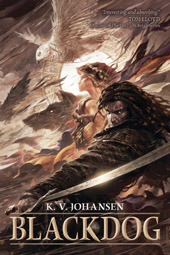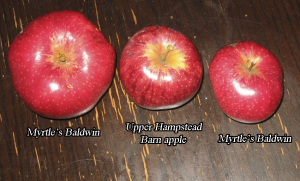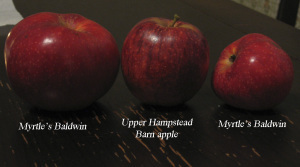K.V. Johansen's Blog, page 9
November 15, 2012
Fruitcake with Canola Oil
Because of some health problems in my extended family, over the past year I’ve been trying to cut butter and lard out of my baking entirely. I even found a couple of canola oil piecrust recipes that work quite well. Fruitcake was the final frontier. Fruitcake is so important; it’s not just cake, but a weight of tradition and memory. (And as well, a great, expensive weight of nuts and dried and candied fruit and peel!) I couldn’t find much online about this experiment except what seemed to be devolving into practically religious arguments over whether canola oil was evil or not. Righteous oil … Well, use whatever cooking oil you like and can afford, I say. But since I found nothing saying either, “Yes, it works,” or, “Yes, it works but cut back the fat by X percent,” or “No, it all falls apart and is a disaster,” I decided the time had come to make the experiment myself, and to report on it. After all, I’d been using oil in every other cake I made for a year quite successfully.
Yesterday I made Dundee cake, and substituted canola oil for the butter, cup for cup. The cakes (three of them, a middle-sized round, a small round, and a large loaf) turned out very well. They have a bit more crust than a firm cake usually has, but my oven cooks bread in half the time yet adds twenty minutes to most large cakes, so it has — um, superficial, non-penetrating heat? a physicist should look into that — so the crust might be the oven rather than the oil. It’s been so long since I made a cake without oil that I can’t remember if my cakes were like that before the great oil shift or not! Possibly laying a sheet of tinfoil overtop once it is set would could slow the surface browning. The crumb is a bit coarser than than one expects in a Dundee cake, but I’m also an inveterate tinkerer and this particular batch of cakes had 1/5 rye flour, which probably accounts for that change in texture. (More of an inspirational alchemist than a proper experimental chemist, I guess — I know one ought to change only one variable at a time in an experiment.) Although a little coarser, it was neither crumbly nor greasy nor dry. It tastes as a Dundee cake ought, all citrus and almond, no canola overtone.
All in all, I’d say it was a very successful experiment and yes, Virginia, you can substitute canola oil for butter in fruitcake, and thereby lower the cholesterol and saturated fat a great deal. (Don’t worry about the ten eggs. The aim is lowering, while still having a proper fruitcake that tastes just like your mother’s/grandmother’s/great-grandmother’s, because that’s what you want at Christmas. And eggs have lutein and other good stuff in them. And those ten eggs were spread out over three cakes. And you shouldn’t eat it by the pound, after all, whatever the state of your health.)


Mystery Apple Identified?
The mystery apple in the previous post has been tentatively identified as a Blue Pearmain. I’d have to see and most importantly, taste, a definite Blue Pearmain to be certain, but based on illustrations and the extremely detailed description in The Apples of New York (published by the Geneva Experimental Farm in New York state, 1905), that’s what I think it must be. My graft of it looks good, healthy, with nice plump buds despite all the leaves dying in the August drought, so possibly I have a Blue Pearmain of my very own. Now I just need a place of my own to plant my brutally pruned and root-pruned orchard and arboretum, which is continually cut back to keep it potentially capable of peregrination, when the time comes. As it must. Someday. Surely.


November 2, 2012
Mystery Apple – Neither Baldwin nor Baxter
One of my favourite apples was identified years ago by an old woman who was getting a bit blurry in her memory as Baldwin, and since it more or less fit the written descriptions, that was what I’ve been calling it. Now my aunt has brought me some definite Baldwins and — the pair of trees I like so much are not Baldwins after all. Nor, when my aunt brought me Baxters, are they a Baxter, though they are a bit like. The Baxter is blander than my “barn apple”, as I shall now call it. I’m wondering if maybe it might be Blue Permain –except I’ve never particularly noticed the distinctive blue bloom a Blue Pearmain is supposed to have.
The middle apple looks more like a Baxter (not shown) than it does a Baldwin, but the texture is wrong. It’s crispier, finer, more tart and more aromatic than the Baxter and far more so than the Baldwin.
Any suggestions? It’s the colder end of zone 5, I think.


October 27, 2012
Sixteen Questions Kids Ask Writers
“Did you write that book?”
“Are you rich?”
“Do you know that guy that wrote The Hobbit?” (A question which at least indicated the grade four boy asking it had read The Hobbit.)
“Do you know J.K. Rowling?”
“Can I go to the bathroom?”
“Are you J.K. Rowling?”
“What’s a spear?”
“Did you come in a limousine?”
“Um … I forget?”
“Is that cop car yours?” (Instant +10 coolness if the answer is “Yes.” Sadly, I’ve come down in the used car world since then.)
“Um … I forgot again?”
“Do you use webs?” (Apparently some current paedogogical theory about How to Write. The correct answer is, “No, that’s Spiderman. I type,” followed by a discussion of the writing process.
“Do you know Rick Riodan?”
“Do you know any authors?” (In evident despair at my failure to regularly partake of cocktails with Rowling and Riodan.)
“Are you famous?”
And, from a small mob, after cornering me in the hall in pursuit of autographs, “Who are you?”
And this, folks, is why it’s a Good Thing, if you’ve invited an author in for a class visit, to actually read them a book by said author beforehand, and perhaps to have them write down for themselves a question or two they’d like to ask about it or about writing … because although these are funny, at the end of the day they are not (other than the “webs” one), very useful.


October 5, 2012
Blackdog on Kobo & Nook
Blackdog is now available through Kobo, for all those use prefer ebooks. Here’s the link to it.
And, it’s out for Nook as well, which you can find here.


Blackdog on Kobo
October 1, 2012
Dispatch from the Desk: Help, I’ve Lost My MacGuffin
About eighteen months ago, I completely abandoned a two-thirds-done Torrie book for which I had no particular deadline in order to work on something that was more urgent. A couple of days ago I went back to it and read it through, thinking it was time I finished it off. I enjoyed it a lot, but I felt a growing anxiety as I read. The … thing, let us call it, the item, the MacGuffin, that Torrie and Wren are guarding and conveying from A to B, the thing, the item, the MacGuffin that C is sending to D, that the brigands of E have been so desperately seeking and that the goblins are also after, in part to prevent E, with which and whom they seem to have a feud of some sort, from getting it — um … why? As a reader, I was eager to find out. As someone who should be presumed to know, I was a bit worried.
I know I used to know. One of nature’s “make it up/discover as one goes along” writers, my stories do often take me by surprise. I had no idea the Blackdog was what he turned out to be until Moth actually told him herself. I was really excited about that. (Which makes me rather peevish about a review that gave that away, as though it were something obvious everyone needed to know before reading the book. May the fleas of a thousand camels infest … ahem. Right. Never curse reviewers, especially when they actually liked the book.) In this case, though, the MacGuffin is the raison d’être of the plot and I know I knew from the start why. It’s just slipped my mind.
Alright, I told myself. I always make notes about the ending and assorted scenes and details at the end of the file, as notions occur to me. It’ll be there. Just enjoy rediscovering the story, so you know where you were. I got to the end of the file. There were a few notes. None had anything to do with the MacGuffin. The story breaks off with two different versions of Torrie getting captured by E; one is clearly better, the other has some nice phrases I wanted to cannibalize. No problem there. No MacGuffin revealed, either in notes or by E twirling her moustaches in a properly villainous fashion as she ties him to the railway track,* announcing just why she wants the darned thing and what she’s going to do with it when she gets it.
Alright. No panic. It’ll be in my notebook, anyway.
Torrie notebook. Torrie notebook. Torrie notebook? Where the heck is my Torrie notebook? Or, my stack of Torrie notebooks, there being a stack of them by this point in Torrie’s career. My study is very small and very full of books and dictionaries and stacks of books and milk-crates of notebooks and heaps of papers, but it’s all organized. I know where everything is, for a certain definition of “know”. I know where the most recent Torrie notebook was two years ago. It isn’t there now; that stack contained three issues of Mallorn, two Amon Hens, the Blackdog notebook, the Moth notebook, two dictionaries, and the proof of a book I was proofreading for someone else a year ago. Also a note saying, “milk. bikkits. bananas.”
Rootling in other stacks and milk-crates has so far turned up among many other things, some old nursery catalogues, the Cassandra notebook, the notebook for an abandoned book I refer to as the Aeneid, and, in fact, the MS of the first Torrie book, which takes us rather far back in the archaeological stratigraphy. It has not, however, turned up a single Torrie notebook, let alone the most recent one. This leads me to conclude that in some mad fit of tidying I put them all together in some logical place.
Oh. Dear.
“Look,” says the Spouse, applying logic to the issue, as he is wont to do, “if you find it, after two years and with your handwriting you won’t be able to read it anyway. Just make up something new.”
Ah, my helpmeet in times of distress and dismay.
On the other hand (since, sadly, he is in fact perfectly correct in this assertion), now I get to discover all over again why everyone is so eager to get their hands, or paws, or claws, on this MacGuffin and how it was going to wrap up the various threads of the plot, once it and all the people desirous of it ended up in the same place, which, according to the notes that do exist, isn’t the maharajah’s palace after all, but a certain small village off in the jungle. That in itself ought to be a clue, I suppose.
I hope.
Wish me luck.
* A metaphorical railway track, obviously, ’cause it’d be too great an anachronism even for Torrie, otherwise, much as he does like his hat-racks** and tin mugs and tea. Also metaphorical moustaches, E being of the female persuasion and not Lord Abastor/Barramundi. Though he does put in an appearance ….
** Do you know why Cossypha has a hat-rack to hang her sword on in the original Dragon? It’s because Peter Davison’s Doctor had a hat-rack and I always coveted one like it. (Still do.) Sometimes an anachronism is just an anachronism. Sometimes it’s fun.


September 22, 2012
Wanderers in the Wilderness
Lately I’ve been reading Alexander’s Prydain books aloud to the Spouse and re-reading Buchan’s Huntingtower as well; it got me thinking about the dearth of solitary wanderers in recent fantasy.* Prydain is a world of forests and hills, with scattered small settlements; its heroes wander alone, like Prince Gwydion, or in small bands, like Taran, Eilonwy, Gurgi, and Fflewddur Fflam. Aragorn and Gandalf wander unsupported, as do Frodo and Sam. The hero of Michael Scott Rohan’s Winter of the World trilogy, Alf/Alv/Elof, travels alone or with two or three friends; Cherryh’s Morgaine and Vanye, McKinley’s Aerin, Cooper’s Indigo, Taylor’s Hawklan, all move through their worlds largely as Romance knights on quests do, alone or with a few companions. In this, many of these fantasies, which evoke in some respects an earlier world than the High Middle Ages, have heroes who, in their mode of adventure, are more like Erec or Lancelot than Aeneas, Beowulf or Sigmund of the Nibelungenot. No comitatus, no entourage, no unnamed body of armed retainers accompanies them. Sigurd of the Volsungasaga and Beowulf both have early episodes of solitary adventure before attaining their mature status and the following that comes with it, but in both cases the story is focused on the events of the established hero, whose solitary past is behind him. His deeds have won him followers, we the listeners do hear the tales of the youthful deeds, but these lay the foundation for the present story, the main plot of the kings and the champions of kings, dead or living but either way sweeping their followers after them. (It occurs to me that this is because authors of Romance were writing fantasy, whereas composers of Epic, despite the legendary or even mythic foundations of their material and the fantastic elements so much a part of it, had to meet demands of realism different from those in Romance. Kings and warleaders behaved in an expected way. A man of proven prowess would not, in maturity, be solitary.)
In contrast, the lone wandering hero’s story in the Romance mode usually ends, for the readers or listeners, when his or her quest has been achieved. In The Lord of the Rings, Frodo, Gandalf, and Aragorn have all arrived at their individual conclusions; Frodo and Gandalf leave the world; Aragorn remains, but save for an appendix, his story for us is over, evil is, for a time, defeated, the kingdom is re-established and restored and for him, the time of romantic solitary wandering is past. (I suppose in Aragorn’s case it ends with the meeting with Halbarad, when he becomes a proper epic warleader and enters on that mode of heroism, with his followers about him; one could say that at this point he moves from Romance to Epic.) For the heroes of the fantasy of the sixties to the early nineties, as well, the defeat of greater-than-human evil or human tyranny and evil (great enough without supernatural aid) and the restoration of peace and order is the quest to be achieved. Once it is, the story we are being told of the hero, even if like Taran or Aerin they have assumed a position of authority in their society, ends. Some, like Morgaine and Vanye, whose quest to destroy the world gates is an ongoing one, will continue to wander. The wandering, the errant in knight-errantry, is the dominant movement of the story. There is a romance in the lone wanderer, the tiny band of comrades, the landscape of wilderness, that belongs to Romance, not to Epic or to the chronicle of politics played out through kings and battles, diplomacy and espionage. The latter has its own romance, but it is not that of the Romance world, nor that of Epic with its mythic underpinnings.
Modern fantasy has never been all about wandering heroes, but it seems to me, as a reader, that there are fewer of them these days than there used to be. When I pick up something new, odds are it will turn out to be about a protagonist who, even if an alleged loner, a thief, assassin, or outcast, will be shown as part of a complex social web that will play an on-stage role throughout the story, and most fantasies, even those with a medieval-ish society, seems to have an urban framework and setting. Has society, the Average Reader, lost interest in Romance, lost touch with the romance of wilderness and wild and the hero’s semi-solitary journey? Are people too removed from solitude for it to engage their imaginations, or to conceive of strength and salvation arising from the individual rather than the group? I hardly ever see the neighbourhood students walking down the road without either headphones on, cellphone to the ear, or a texting thumb at work. Is there ever any solitude for them, any quiet, any journey in which the mind can be still and observe and the self be alone to confront the self, and is this why the wanderer seems to have fallen out of fashion?
*Huntingtower (1922), for those unfamiliar with it, is not fantasy, but the story of a well-off retired Scottish grocer who sets off on a walking holiday and is caught up into a romantic adventure with a cynical Modern poet and an exiled Russian princess. There is much in it about the romance of adventure. It’s dedicated, by the way, to the scholar W.P. Ker, author of Epic and Romance.


September 3, 2012
Dispatch from the Desk: It’s Done
The book is done. Finally.
I think I’ll go collapse in a gibbering heap somewhere for a bit.
What more can I say about it? Not much, at present. A couple of new characters I’m really excited about, a previous villain now turned hero, and completely unintentionally, nearly all the fighting takes place at night.


September 2, 2012
Ginger beet soup
In lieu of an update on progress on the book, which should be done by tomorrow, I think (if saying so didn’t just jinx it), and due to my having found a large bag of beets in my fridge and needing to deal with them before they go wibbly, thewildforest blog is pleased to present a beet soup recipe I seem to have come up with some time ago. As you can see, left to my own devices I resort to the Nanny Ogg school of ingredient measurement, the “some”. All the below should read as “some”; even the number of beets would be better represented by “some beets” than half a dozen. Please note, much to my mother’s dismay I also adhere to the school of cookery that believes a good soup is one in which a spoon can stand upright. You may want to add some more water. Or some fewer beets. Or something.
This is my own aide-memoire written after the first time I made it (or possibly I typed it out to send to a sister, can’t remember). Anyway, that’s my excuse for the sophisticated terminology.
Very Tasty Beet Soup
six cooked beets
an onion
lemon juice
cumin, coriander, ginger (generous amounts; real ginger would be good)
miso
pinch of sugar
Sautee onion in oil with spices. Add lemon juice and scrape around to get all the brown stuff.
Put three beets in blender, add one cup of water and cooked onions; blend. Dump back in pot. Do second three beets with a second cup of water and enough miso for two cups of stock (two smallish spoonfuls), blend and return to pot. Stir up, add a tiny bit of sugar and heat, stirring. Add pepper and a dash of olive oil.







